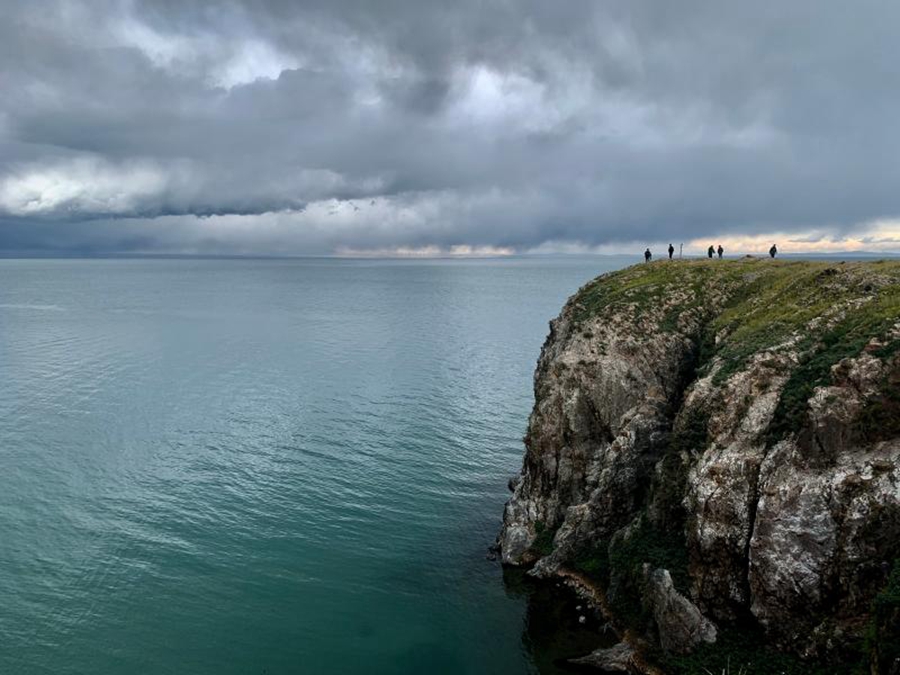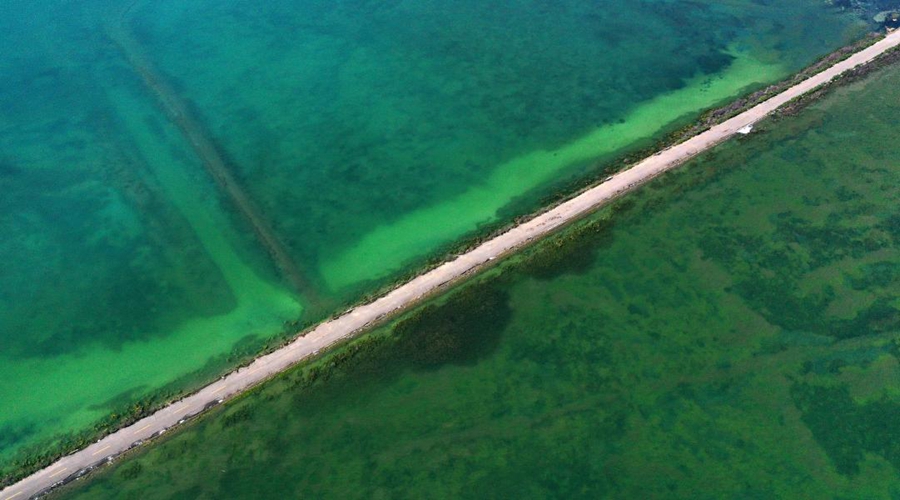Great lake on Qinghai-Tibet Plateau takes on a new look
Qinghai Lake is a crucial body of water to maintain ecological security in the northeastern Qinghai-Tibet Plateau. It offers a glimpse into the improving ecology of the "roof of the world" as well as the determination of the Chinese government to pursue green development through decades of protection of the lake.
As a red sun rose behind the clouds and reflected on the water, visitors and shutterbugs followed paths along the shore of the Qinghai Lake in the chattering of ruddy shelducks and brown-headed gulls looking for the best spot to capture the lake as it sparkled in the first rays of dawn.

File photo taken on Sept. 24, 2019 shows a view of the Bird Island at Qinghai Lake, northwest China's Qinghai province. [Photo/Xinhua]
The spectacular and colorful views provide a unique raw landscape for creations from photographers and oil painters.
Qinghai Lake, China's largest inland saltwater lake in the northwestern province of Qinghai, is a crucial body of water to maintain ecological security in the northeastern Qinghai-Tibet Plateau.
It offers a glimpse into the improving ecology of the "roof of the world" as well as the determination of the Chinese government to pursue green development through decades of protection of the lake.

File photo taken on Sept. 11, 2019 shows birds and naked carp, a fish species endemic to the lake that once sharply declined due to over-fishing, at Qinghai Lake, northwest China's Qinghai province. [Photo/Xinhua]
Protecting species gene pool
With a maximum altitude of 5,291 meters, the Qinghai Lake, which straddles two Tibetan autonomous prefectures of Hainan and Haibei in the province, has a water area of 4,549.38 square kilometers, a gene pool for species on the Qinghai-Tibet Plateau.
In 2008, the province launched a 10-year plan on the ecological environment protection and comprehensive management of the Qinghai Lake Basin with a total investment of 1.57 billion yuan (about US$226 million).
A total of 800 hectares of wetland had been restored by 2018, with banning, delaying and rotational grazing implemented on more than 31,000 hectares of land.
Restoration programs were launched in bird habitats, which have brought up the number of bird species in the lake region from 164 in 1996 to 225 at present.
The lake has become a key habitat for wintering of more and more migratory birds, with over 100,000 birds making a stop here during migration every year, including rare species like whooper swans and black-necked cranes, according to He Yubang, head of the Qinghai Lake national nature reserve's administration.
Artificially-bred fry of naked carp, a fish species endemic to the lake that once sharply declined due to over-fishing, have been released into the lake since the late 1990s, with a fishing ban starting in 2000. By the end of last year, the lake contained some 93,000 tonnes of naked carp, more than 30 times the number in 2002.
"The improving aquatic ecosystem of the Qinghai Lake has made it one of the regions with the richest biodiversity on the plateau," said Wang Enguang, deputy director of the provincial forestry and grassland bureau.

Aerial photo taken on July 10, 2020 shows a road to the Bird Island with both sides submerged at Qinghai Lake, northwest China's Qinghai province. [Photo/Xinhua]
Beating climate change challenges
Research by the Chinese Academy of Sciences and other institutions shows that the dry climate in northwest China might be turning humid due to the increase in precipitation.
The area of Qinghai Lake has shown an increasing trend since 2005, with the water level rising by 3.27 meters in 15 years, according to monitoring data of the provincial institute of meteorological sciences.
Getting warmer and moist improves the local ecological environment, yet the rising waters made the habitat of Przewalski's gazelles, an endangered antelope species named after Russian explorer Nikolai Przhevalsky who found a specimen and brought it back to St. Petersburg in 1875, to shrivel.
"Our protection station used to be on Bird Island which lies northwest of the lake, and was then moved to the south shore," said 57-year-old Wu Yonglin with the nature reserve, who has participated in monitoring, rescue and artificial breeding of the wildlife species since 2003.
At present, there are 14 populations of Przewalski's gazelles near Qinghai Lake, with the total number increasing from some 300 in 1994 to over 2,700, Wu added.
Pastures and houses of local herders were also threatened by rising water levels.
In Shinaihai township of Hainan Tibetan autonomous prefecture, five houses have been submerged, with 5,400 hectares of grazing land waterlogged, according to Zhaxi, head of the township.
The government has given subsidies to those who lost their land and property and helped them relocate from the core reserve area by the lake to a new settlement site, Zhaxi said.

Tourists enjoy their leisure time at Qinghai Lake, northwest China's Qinghai province, July 30, 2020. [Photo/Xinhua]
Promoting national park construction
As the COVID-19 epidemic wanes in China, trans-provincial tourism is gradually resuming, attracting many self-driving travelers to the Qinghai Lake in early August.
The Qinghai Lake scenic area, one of the highest-rated national tourist attractions, received 4.42 million visitors last year, with an annual tourism revenue of 265 million yuan, according to the lake's management bureau.
Meanwhile, the provincial authorities have been pondering over the protection of the lake in an attempt to find a balance between protecting and developing the national nature reserve.
Bird Island scenic spot was closed in 2017, leaving only a base for science education and waterbird monitoring facilities. At another closed scenic spot, Sand Island, tourist facilities were dismantled and recreational programs like sand motorcycling and sliding were banned.
"Bird Island, once bustling with tourists, has been restored to its original beauty and is home to a large number of birds," said Yang Tao, deputy head of the Qinghai Lake national nature reserve's administration.
China is setting up a national park system and has piloted 10 national parks across the country to protect the natural environment and endangered species, with the Sanjiangyuan National Park in Qinghai being the first. Under construction since 2016, the park is set to open in 2020.
The provincial government of Qinghai also rolled out a three-year action plan early this year, which clearly proposes the planning and construction of the Qinghai Lake National Park.
He Yubang said national park construction is "the pearl on the crown of a beautiful China," and hopes that Qinghai Lake could have a more integrated ecosystem in the future.
"The glittering and translucent sapphire mounted in the vast expanse of the plateau will be the beautiful nostalgia of the local people," He said.

